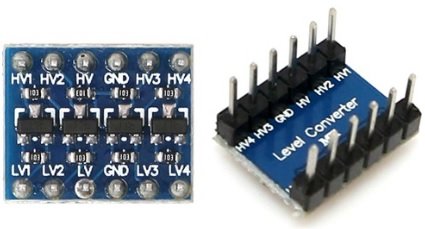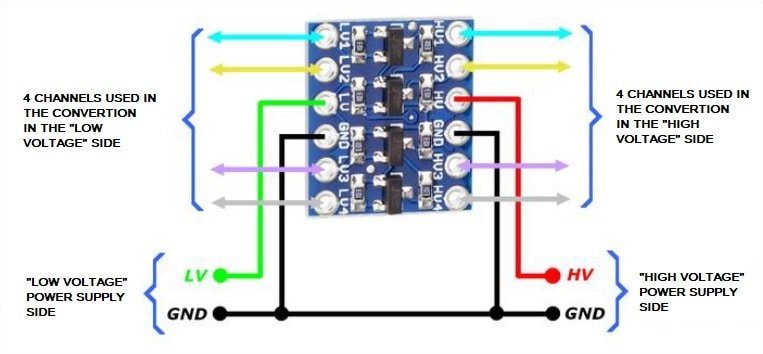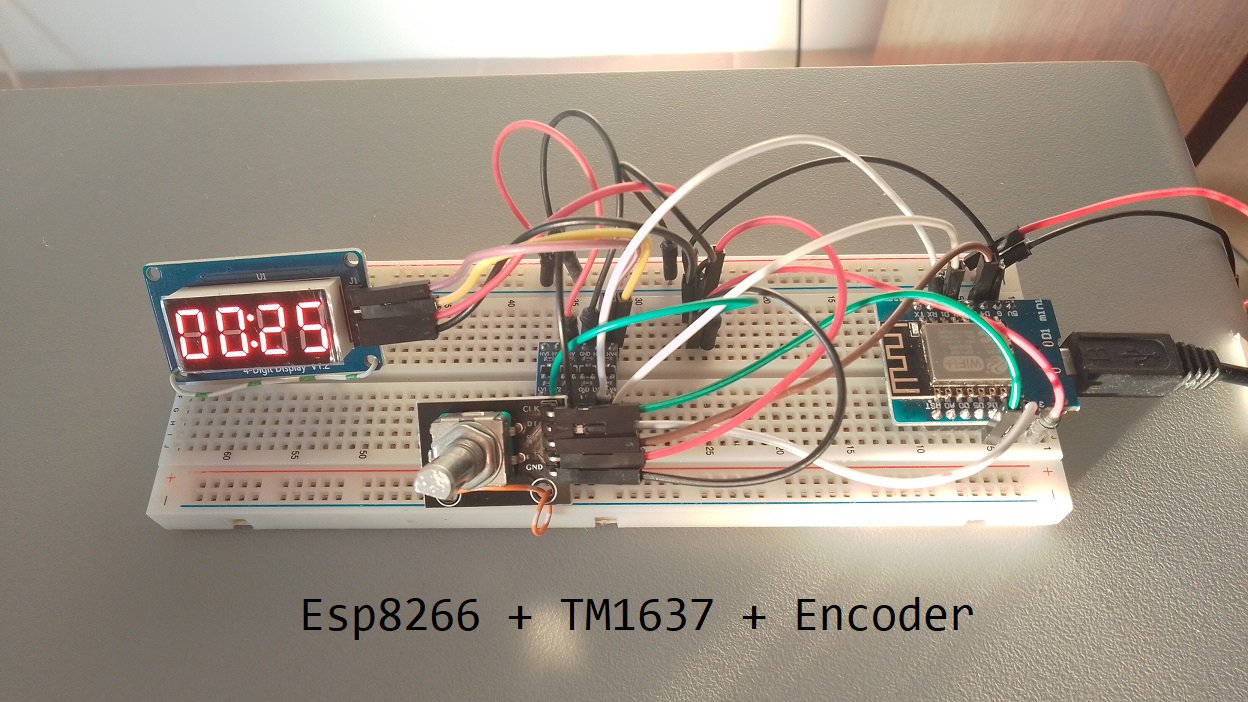Countdown Timer with Esp8266 + TM1637 and Encoder
In this tutorial, we’ll guide you through the process of creating a versatile and interactive countdown timer using a Wemos D1 Mini, a TM1637 4-digit 7-segment display, and a KY-040 rotary encoder. This project is not only a great way to learn about Arduino programming but also provides a practical application for everyday scenarios like cooking, workouts, or any activity that requires precise timing.
Components You’ll Need:
- ESP8266 Development Board (such as NodeMCU) (Affiliate) – https://s.click.aliexpress.com/e/_DD3JQhj
- TM1637 display module (Affiliate) – https://s.click.aliexpress.com/e/_DCwvPgx
- KY-040 rotary encoder (Affiliate) – https://s.click.aliexpress.com/e/_Dl3uGHB
- Logic Converter (Affiliate) – https://s.click.aliexpress.com/e/_Dmx9x5D
- Breadboard and jumper wires (Affiliate) – https://s.click.aliexpress.com/e/_Dl5kuk1
Understanding the Logic Level Conversion
The Wemos D1 Mini operates at 3.3V, while the TM1637 typically works at 5V. To bridge this voltage gap, we’ll use a logic level converter to ensure proper communication between the devices.


Setting Up the Hardware:
Begin by connecting the components as follows:
- Connect the CLK pin of the KY-040 encoder to D6 on the Wemos D1 Mini.
- Connect the DT pin of the KY-040 encoder to D7 on the Wemos D1 Mini.
- Connect the SW pin of the KY-040 encoder to D4 on the Wemos D1 Mini.
- Connect the DIO pin of the TM1637 display to D2 on the Wemos D1 Mini.
- Connect the CLK pin of the TM1637 display to D1 on the Wemos D1 Mini.

Installing the Required Library:
Open the Arduino IDE, go to “Sketch” → “Include Library” → “Manage Libraries” and search for “TM1637”.
- Install the library authored by “Avishay” latest version

The code
Variable Declarations:
int encoderValue = 0; int lastCLKState; int lastDTState; bool buttonPressed = false; bool timerRunning = false; unsigned long countdownStartTime; unsigned long countdownDuration = 0; int lastDisplayedValue = -1;
Setting Up the Display in the Setup Function:
void setup() {
pinMode(CLK, INPUT);
pinMode(DT, INPUT);
pinMode(SW, INPUT_PULLUP);
lastCLKState = digitalRead(CLK);
lastDTState = digitalRead(DT);
Serial.begin(115200);
display.setBrightness(7);
display.showNumberDec(0);
}
The setup function initializes the pins, sets up the serial communication for debugging, and initializes the TM1637 display.
Loop Function – Handling Encoder and Timer Logic:
void loop() {
int currentStateCLK = digitalRead(CLK);
int currentStateDT = digitalRead(DT);
if (currentStateCLK != lastCLKState) {
if (currentStateCLK == HIGH) {
if (currentStateDT == LOW) {
encoderValue++;
} else {
encoderValue--;
}
if (encoderValue < 0) {
encoderValue = 0;
}
if (encoderValue != lastDisplayedValue) {
Serial.print("Selected Time: ");
Serial.println(encoderValue);
display.showNumberDec(encoderValue, false);
lastDisplayedValue = encoderValue;
}
}
}
lastCLKState = currentStateCLK;
lastDTState = currentStateDT;
if (timerRunning) {
unsigned long elapsedTime = millis() - countdownStartTime;
if (elapsedTime >= countdownDuration * 1000) {
Serial.println("Countdown complete");
timerRunning = false;
Serial.println("Input enabled");
display.showNumberDec(0, false);
} else if (elapsedTime % 1000 == 0) {
int remainingTime = (countdownDuration * 1000 - elapsedTime) / 1000;
int minutes = remainingTime / 60;
int seconds = remainingTime % 60;
Serial.print("Remaining Time: ");
Serial.print(minutes);
Serial.print(" minutes and ");
Serial.print(seconds);
Serial.println(" seconds");
display.showNumberDecEx(minutes * 100 + seconds, 0b11100000, true);
}
}
if (digitalRead(SW) == LOW && !buttonPressed && !timerRunning) {
buttonPressed = true;
timerRunning = true;
countdownStartTime = millis();
countdownDuration = encoderValue * 60;
lastDisplayedValue = -1;
Serial.print("Countdown started for ");
Serial.print(countdownDuration / 60);
Serial.print(" minutes and ");
Serial.print(countdownDuration % 60);
Serial.println(" seconds");
} else if (digitalRead(SW) == HIGH && buttonPressed) {
buttonPressed = false;
}
delay(1);
}
Complete Code
#include <TM1637Display.h>
const int CLK = D6;
const int DT = D7;
const int SW = D4;
const int DIO = D2;
const int CLK_TM1637 = D1;
TM1637Display display(CLK_TM1637, DIO);
int encoderValue = 0;
int lastCLKState;
int lastDTState;
bool buttonPressed = false;
bool timerRunning = false;
unsigned long countdownStartTime;
unsigned long countdownDuration = 0;
int lastDisplayedValue = -1;
void setup() {
pinMode(CLK, INPUT);
pinMode(DT, INPUT);
pinMode(SW, INPUT_PULLUP);
lastCLKState = digitalRead(CLK);
lastDTState = digitalRead(DT);
Serial.begin(115200);
display.setBrightness(7);
display.showNumberDec(0);
}
void loop() {
int currentStateCLK = digitalRead(CLK);
int currentStateDT = digitalRead(DT);
if (currentStateCLK != lastCLKState) {
if (currentStateCLK == HIGH) {
// On rising edge of CLK
if (currentStateDT == LOW) {
// Clockwise rotation
encoderValue++;
} else {
// Counter-clockwise rotation
encoderValue--;
}
// Ensure encoderValue is not negative
if (encoderValue < 0) {
encoderValue = 0;
}
if (encoderValue != lastDisplayedValue) {
Serial.print("Selected Time: ");
Serial.println(encoderValue);
// Display selected time on TM1637
display.showNumberDec(encoderValue, false);
lastDisplayedValue = encoderValue;
}
}
}
lastCLKState = currentStateCLK;
lastDTState = currentStateDT;
if (timerRunning) {
unsigned long elapsedTime = millis() - countdownStartTime;
if (elapsedTime >= countdownDuration * 1000) {
Serial.println("Countdown complete");
timerRunning = false;
Serial.println("Input enabled");
// Display "done" on TM1637
display.showNumberDec(0, false);
} else if (elapsedTime % 1000 == 0) { // Update display every second
int remainingTime = (countdownDuration * 1000 - elapsedTime) / 1000;
int minutes = remainingTime / 60;
int seconds = remainingTime % 60;
Serial.print("Remaining Time: ");
Serial.print(minutes);
Serial.print(" minutes and ");
Serial.print(seconds);
Serial.println(" seconds");
// Display remaining time on TM1637
display.showNumberDecEx(minutes * 100 + seconds, 0b11100000, true);
}
}
if (digitalRead(SW) == LOW && !buttonPressed && !timerRunning) {
buttonPressed = true;
timerRunning = true;
countdownStartTime = millis();
countdownDuration = encoderValue * 60; // Set countdown duration based on encoder value
lastDisplayedValue = -1; // Reset last displayed value
Serial.print("Countdown started for ");
Serial.print(countdownDuration / 60);
Serial.print(" minutes and ");
Serial.print(countdownDuration % 60);
Serial.println(" seconds");
} else if (digitalRead(SW) == HIGH && buttonPressed) {
buttonPressed = false;
}
delay(1);
}
Testing
Conclusion
The loop function handles encoder input, updates the display, and manages the countdown timer logic based on button presses. The code provides real-time feedback on the selected time and the remaining time during the countdown.
